이념의 기록 :: 송인展
Song In Solo Exhibition :: Painting
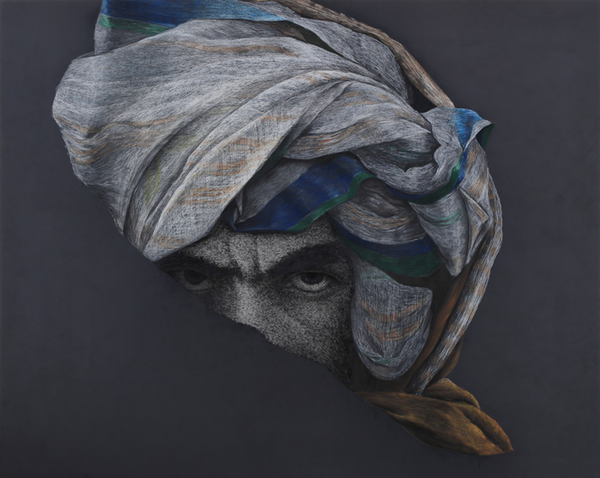
▲ 송인, 예기치 못한 사건으로부터
장지, 먹, 수정테이프, 아크릴, 콩테, 오일파스텔
130 x 162cm, 2022
작가 ▶ 송인(Song In)
일정 ▶ 2023. 10. 31 ~ 2023. 11. 05
관람시간 ▶ 10:00 ~ 19:00
∽ ∥ ∽
비오케이아트센터(BOK Art Center)
세종시 국책연구원 3호 12, 6층
1877-4955
∽ ∥ ∽
2023 세종시 전문예술 창작지원사업
● 심연에서 떠오르는 얼굴
이선영(미술평론가)
깊은 어둠 속에서 서서히 드러나다 확 다가오는 느낌을 주는 독특한 초상들은 송인 방식의 메멘토 모리(Memento mori)이다. 초상화에 본래부터 내재하는 부재와 죽음의 은유는 그의 작품에서 더욱 두드러진다.
먹과 아크릴 등으로 처리한 바탕은 한 줄기 빛도 빠져나올 수 없을 듯한 깊은 어둠을 깔아놓는다. 한편 거기에서 떠오르는 듯한 얼굴은 수정테이프로 붙여가며 제작되었다. 수정테이프는 얇기는 하지만 페인팅이 아니라 일종의 꼴라주기 때문에 환영보다는 물성이 강조된다. 최초부터 마지막까지 6겹까지 붙여서 볼륨감을 주는 기법은 화면 속 얼굴을 관객의 면전으로 더 가까이 들이대는 효과를 자아낸다. 그러면서도 화면과의 밀착도가 있다. 회화적 실험 과정에서 우연찮게 발견한 수정테이프는 정착액을 계속 뿌려가면서 작업해야 하는 번거로운 ‘매체’이기도 하다. 또한 그것은 그리기와 지우기라는 행위를 중첩시키는 은유적 효과도 있다. 빛과 어둠의 대조라 할 만하지만, 작가는 얼굴 윤곽선을 흐릿하게 처리하여 초상화에 기대될 법한 영원성을 약화시켰다. 수정테이프로 ‘그린’ 얼굴은 어두운 바탕에 밝은 얼굴이다. 하지만 빛을 받은 얼굴 표면에도 어둠을 내포한다. 또한 작가는 침묵의 카르텔을 통해 사회의 부조리와 모순이 감춰지는 현상을 고발한다. 동작은 물론 말이 없는 매체인 회화는 정지와 침묵을 통해 말한다. 타자와의 번거로운 일에 얽히기 싫어하는 관행이 언젠가 자신에게도 피해를 줄 수 있다는 사실을 말한다. 침묵이라는 키워드가 들어간 작가의 작품들은 많이 있다. 이전 작품들인 [가려진 사건](2019)이나 [강제된 침묵-너만 눈 감으면 돼](2017), [강제된 침묵-너만 안 들으면 돼](2017)는 모두 약자를 희생자로 삼는 사건에 대한 고발이다. 강요받은 침묵의 대상은 죽음에 가까운 상처를 주는 사건일터이다. 작가는 현실 속에서 현상을 관찰해보면 즐거움보다 괴로움이 많다는 것을 느낀다. 그는 현시대 고통의 원인을 ‘타자와의 소통의 부재’로 본다. 그것은 ‘갈등과 폭력으로 이어져 왔다’고 생각한다.
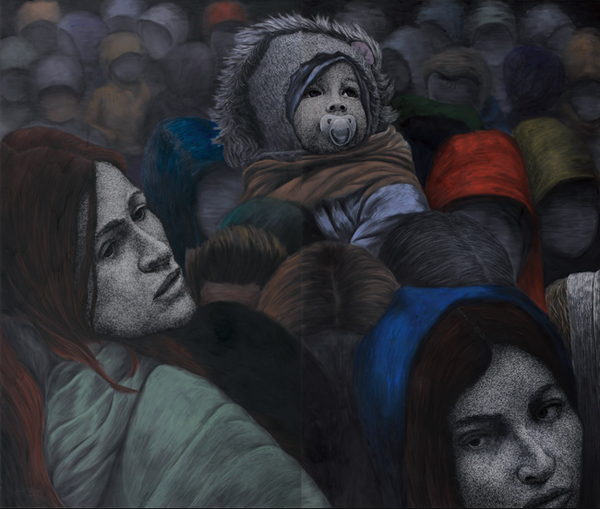
▲ 송인, 악몽이 된 어느날
장지, 먹, 수정테이프, 아크릴, 콩테, 오일파스텔
162.3 x 190.2cm, 2022

▲ 송인, 어떤날의 악몽
장지, 먹, 수정테이프, 아크릴, 콩테, 오일파스텔
162 x 130cm, 2022
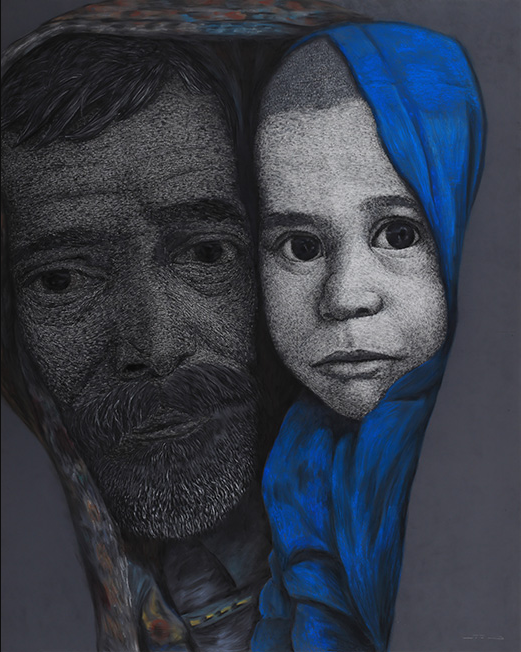
▲ 송인, 어떤날의 상념
장지, 먹, 수정테이프, 아크릴, 콩테, 오일파스텔
162 x 130cm, 2022
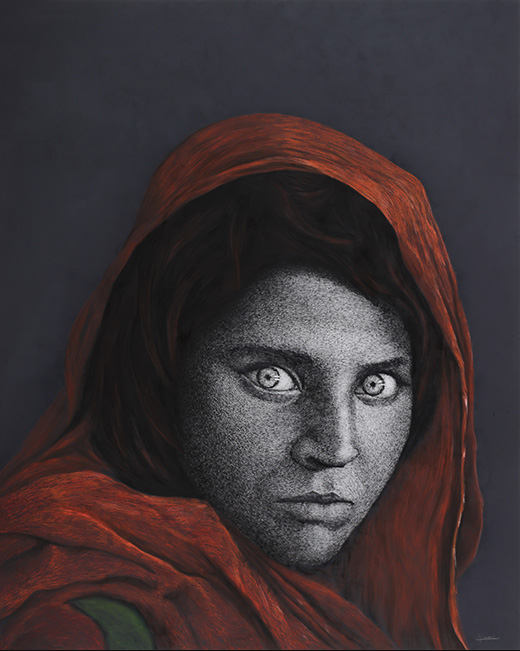
▲ 송인, 그날의 기억
장지, 먹, 수정테이프, 아크릴, 콩테, 오일파스텔
162 x 130cm, 2022
송인은 작품을 통해서 ‘사회 관계망으로 점철된 사회구조 안에서의 서로 상호 간의 비물리적 폭력적 관계에 대한 해석을 심도 있게 다루고자’ 한다. 자연을 비롯해서 타자를 도구화하고 지배하려는 계몽의 책략은 이성과 폭력의 결탁 관계를 말한다. 아도르노를 비롯해 작가가 관심 있어 하는 프랑크푸르트 학파는 이성-계몽-신화-지배의 연결고리를 지적해왔다. 이러한 비판적 사회학을 현대의 정신분석학으로 부연 설명하자면, 라캉이 말한 대타자의 영역으로 구조화된다. 정신분석학에서 대타자(Autre)는 개별적 타인을 넘어서는 언어와 법의 질서이다. 라캉의 이론에 따르면 상징계(the Symbolic)는 절대적 주인이 되어 명령한다. 이성이라는 ‘동일자는 폭력적 전체성’(레비나스)에 사로잡혀 있는 것이다. 이러한 사회적 압력에의 민감도는 작가로 하여금 죽음을 검토하게 한다. 레비나스는 [시간과 타자]에서 ‘죽음의 접근을 통해 알 수 있는 것은 우리가 절대적으로 다른 것과 관계를 맺고 있다는 사실’이라고 말한다. 그것이 작가로 하여금 타자의 초상을 그리게 했다.
송인에게 인간-타자는 불안과 공포에 사로잡혀 있다. 화면 가득히 포착된 얼굴은 스쳐지나가는 눈길로도 사태를 파악할 수 있는 사회적 존재로서의 인간을 염두에 둔다. 존 리겟은 [얼굴 문화, 그 예술적 위장]에서 사회생활을 잘하기 위해서는 다른 사람들의 기분을 직관적으로 파악하고 공감할 수 있는 능력이 있어야 함을 강조하며, 그렇기에 대부분의 반응이 무의식적일 정도로 우리는 사회화되어 있다고 말한다. 얼굴은 사회생물학이나 심리학 등을 넘어서 그 자체로 철학적 윤리적 주제로 확장되며, 그 대목이 미학과의 진정한 연결고리가 된다. 니콜 아블릴은 [얼굴의 역사]에서 얼굴은 가장 인간적인 것이라고 보며, 타인의 얼굴을 철학의 주제로 삼은 레비나스를 인용한다. 이전 시대에 인간은 신의 얼굴을 반영하는 존재였지만, 이제 인간의 얼굴은 레비나스가 말하듯이 ‘불안할 정도로 약해’ 보인다. 막스 피카르가 [사람의 얼굴]에서 한탄했듯이, 이제 ‘얼굴은 판이 되어 가고’, ‘그 판조차 깨져가고’ 있는 것이다. 레비나스는 단순히 타자의 얼굴을 보는 것이 아니라 어루만지기를 권한다. 단지 본다는 것은 타자를 대상화하는 것에 머물기 때문일 것이다. 대상화와 도구화는 가까운 거리에 있다. 레비나스에 의하면 보기는 접촉과 근접성을 유지한다. 요컨대 ‘보기는 만지기와 유사한데, 만지기는 어루만지기로 이해’된다. ‘보면서 나는 얽힌다. 얽히면서 나는 마주치게 된다’는 것이 타자의 윤리학이 전하는 메시지다. 그 점에서 수정테이프를 활용한 작가의 기법이 촉각적 시각성을 부각시키는 것은 의미 있다.
그의 작업실에는 수정테이프가 화가의 물감만큼이나 쌓여있다. 피해를 상시적으로 상상하는 것만으로도 통제 및 조절의 권력이 자동적으로 실행됨을 암시한다. 그의 초상에는 불안과 공포가 편재한다. 경악스러운 장면을 보든 피하든, 사건이 실제로 벌어지든 유예되든 결과는 마찬가지다. 검은 배경은 주체를 위협하는 대상을 드러내기보다는 감추는데, 그것은 프로이트가 대상의 유무에 따라 불안과 공포를 구별했던 것을 상기시킨다. 영화를 비롯한 사각 프레임은 그 내부로 어떤 것이 침입할지 모를, 그 자체가 불안과 공포에 걸맞는 장르처럼 느껴진다. 그의 작품은 언제든 공포와 연결될 수 있는 불안을 표현하며, 검은 배경은 주체를 위협하는, 또는 상호작용하는 타자들이 잠복해있는 잠재적인 영역이다.
송인은 작업 초기에 자화상도 곧잘 그렸지만, 적어도 지금 기법을 시작한 시기인 10여년 전부터 작품에는 자신의 모습이 발견되지 않는다. 작가는 굳이 자신을 그릴 필요가 없다고 봤다. 자기만의 세계에 빠진 나르시시즘의 모습 또한 죽음과 멀지 않지만 그것이 달콤한 죽음이라면, 타자와의 상호작용은 보다 도전적이다. 그림에 이질적인 재료 등은 타자의 또 다른 확장이다. 굳이 자신을 그리지 않아도 되는 것은 타자와 주체의 경계가 유동적임을 말한다. 그것은 주체가 당면한 사태에 대한 보다 냉정한 접근이라고 할 수 있다. 개인적으로는 커밍아웃하여 불행한 말로를 맞은 지인의 사건이 작가에게 큰 충격으로 다가왔고 인간 관계에서 있을 수 있는 불편한 진실에 대해 주목하게 됐다. 상대를 그 자체의 존재가 아니라 자신의 이익을 위한 도구로 삼는 그런 흔해 빠진 ‘진실’ 말이다. 현대사회에 편재하는 경쟁과 권력 관계 속에서 타자는 주체의 희생물이 될 가능성이 크다. 주체는 타자가 되지 않으려고 애쓸 따름이다. 그렇지만 현대의 언어학이나 정신분석학이 예시하듯이 주체는 이미 타자로 이루어져 있다. 작가는 타자를 포기하지 않는다. 그에게 손바닥 만한 얼굴은 인간 삶을 반영하는 거대한 우주다. 그는 ‘관계의 미학’을 말한다. 초상화에서 관계란 타자와의 관계일 수 있다. 자크 랑시에르가 [미학 안의 불편함]에서 말했듯이, ‘예술은 타자와의 충격적인 만남에 의해 규정된 명령’과 관련된다. 하지만 랑시에르는 예술이 지배적 문화와 투쟁하는 가운데, 도발적 이견만을 재현하는 것으로는 충분치 않고 신비로 고양되어야 한다고 본다.
작가의 작품에서 초상만큼이나 중요한 부분을 차지하는 검은 배경은 신비의 측면을 제공한다. ‘타자와의 관계는 신비와의 관계’(레비나스)이기 때문일 것이다. 타인의 얼굴을 오려내 어수선한 꼴라주 기법으로 사회 비판적인 목소리를 드높이는 미술계 경향도 있었지만, 대개 그러한 스타일은 일회용 풍자나 선정적인 표현에 머물고 만다. 포토몽타주는 정치적인 영향력을 크게 발휘했던 영역이기도 했다. 하지만 21세기에 현실의 부조리는 그렇게 대놓고 반대할 만큼 명확히 드러나지 않는다. 층층이 감춰져 있는 현실은 사회운동가들과 다른 입장을 요구한다. 예술은 단정이 아니라 끝없는 해석이기 때문이다. 작가는 자명한 듯 몸에 붙어있는 머리를 소재/주제로 삼아 쓰기와 지우기를 교차하면서 얼굴이라는 미지의 텍스트를 짜나간다.

▲ 송인, Paradox
장지, 먹, 수정테이프, 아크릴, 콩테
70.5 x 67.5cm, 2022
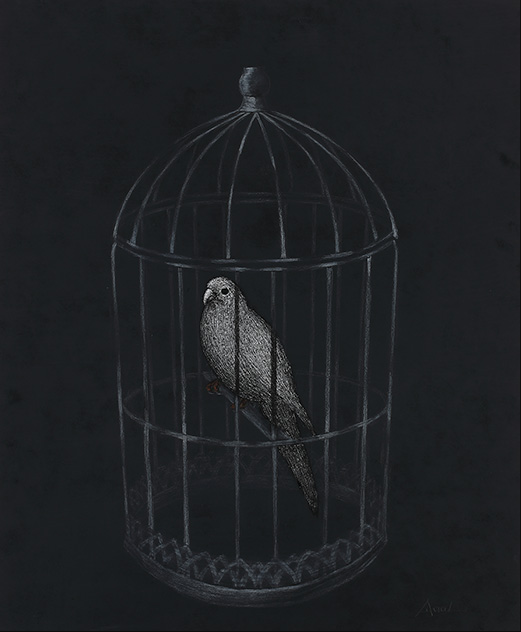
▲ 송인, Paradox
장지, 먹, 수정테이프, 아크릴, 콩테
73 x 60.6cm, 2022
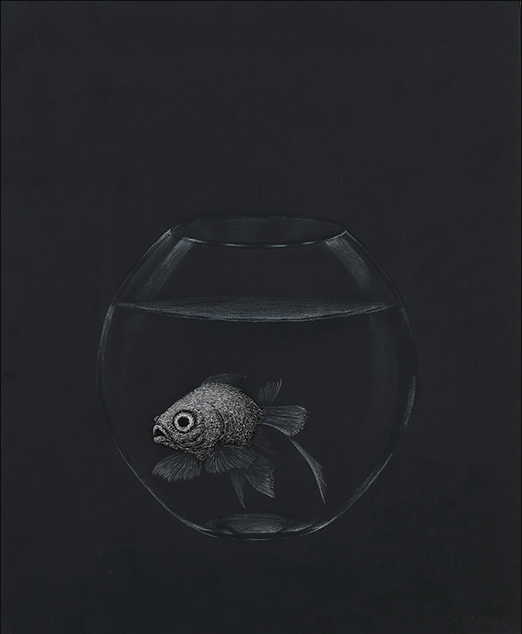
▲ 송인, Paradox
장지, 먹, 수정테이프, 아크릴, 콩테
73 x 60.6cm, 2022

▲ 송인, Paradox
장지, 먹, 수정테이프, 아크릴, 콩테
73 x 60.6cm, 2022
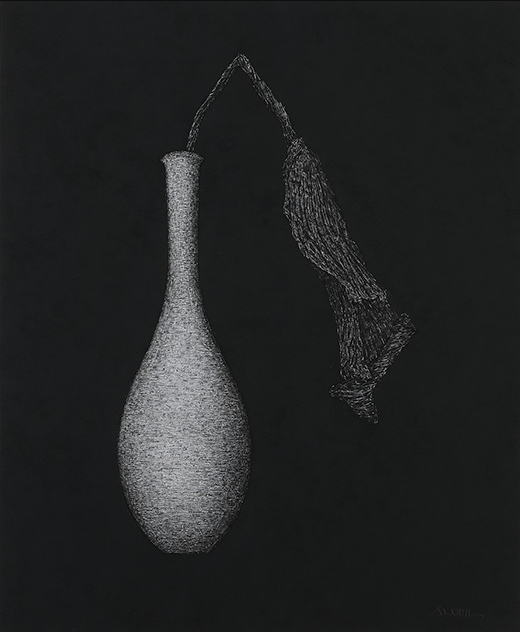
▲ 송인, Paradox
장지, 먹, 수정테이프, 아크릴, 콩테
73 x 60.6cm, 2022
● a face rising from the abyss
Sun young Lee (Art critic)
The unique portraits that slowly emerge in the deep darkness and feel like they are approaching are the Memento mori in the form of a pine tree. The metaphor of absence and death inherent in the portrait is more prominent in his work.
The background treated with ink and acrylic lays a deep darkness that seems to be impossible to escape even a single ray of light. On the other hand, the face that seemed to rise from there was made by attaching it with crystal tape. Although the crystal tape is thin, it emphasizes physical properties rather than welcome because it is a kind of collage, not painting. The technique of adding volume by attaching six layers from the beginning to the end creates the effect of bringing the face on the screen closer to the audience's face. At the same time, it has close contact with the screen. The crystal tape, which was discovered accidentally during the conversational experiment, is also a cumbersome "media" that requires continuous spraying of fixing fluid. It also has a metaphorical effect that overlaps the act of drawing and erasing. It is a contrast between light and darkness, but the artist blurred the facial contour, weakening the eternity that would be expected of a portrait. The 'green' face with crystal tape is a bright face on a dark background. However, the surface of the face that received light also contains darkness. In addition, the author accuses the phenomenon of hiding the absurdities and contradictions of society through the silent cartel. Painting, a medium without words as well as movement, speaks through silence and silence. It refers to the fact that the practice of not wanting to get involved in cumbersome work with others can one day damage oneself. There are many works by the author with the keyword "silence." Previous works, [Covered Case] (2019), [Forced Silence-Only You Need to Close Your Eyes] (2017), and [Forced Silence-Only You Don't Listen] (2017), are all accusations of cases in which the weak are victims. The object of forced silence is an event that is close to death. The writer feels that there is more suffering than pleasure when observing the phenomenon in reality. He sees the cause of today's pain as 'lack of communication with others'. I think it 'has led to conflict and violence'.
Through his work, Song In intends to "in-depthly deal with the interpretation of non-physical and violent relationships between each other in a social structure dotted with social networks." The strategy of enlightenment to instrument and dominate others, including nature, refers to the collusion between reason and violence. The Frankfurt School, which the author is interested in, including Adorno, has pointed out the link between reason, enlightenment, myth, and domination. To add this critical sociology to modern psychoanalysis, it is structured into the realm of the pinch hitter that Lacan said. In psychoanalysis, an autre is an order of language and law beyond individual others. According to Lacan's theory, the symbolic system becomes an absolute master and commands. He is obsessed with the 'violent totality' (Levinas) of reason. This sensitivity to social pressure causes the author to review death. "What we can see from the approach of death is the fact that we have absolutely a relationship with something else," Levinas says in [Time and Typing]. It made the writer paint the portrait of the other.
For Song-in, human-others are obsessed with anxiety and fear. The face, which is fully captured on the screen, is mindful of humans as social beings who can grasp the situation even with passing eyes. John Riggett emphasizes that in order to be good at social life in [face culture, its artistic camouflage], we must have the ability to intuitively understand and empathize with other people's feelings, so we are socialized to the point where most reactions are unconscious. The face extends beyond social biology and psychology to philosophical and ethical topics in itself, and the passage becomes a true link to aesthetics. In The History of Faces, Nicole Ablill cites Levinas, who sees the face as the most human thing, and uses the face of others as the subject of philosophy. In previous times, humans were reflective of God's face, but now human faces look "anxiously weak," as Levinas says. As Max Picard lamented in [Man's Face], there is now "the face is becoming a board" and "even the board is breaking." Levinas recommends touching the batter's face, not just looking at it. It may be because only seeing stays with the objectification of others. Targetization and instrumentation are within a short distance. According to Levinas, bogey maintains contact and proximity. In short, "look is similar to touching, but touching is understood as caressing." 'As I watch it, I get tangled up. The message of the other's ethics is that I encounter as I get entangled. In that regard, it is meaningful that the artist's technique using crystal tape highlights tactile visuality.
In his studio, crystal tapes are stacked as much as the painter's paint. Just imagining the damage on a regular basis suggests that the power of control and control is automatically enforced. Anxiety and fear abound in his portrait. Whether you see or avoid shocking scenes, whether the event actually takes place or is suspended, the result is the same. The black background hides the object that threatens the subject rather than reveals it, which reminds Freud of his distinction between anxiety and fear according to the presence or absence of the object. The square frame, including the movie, feels like a genre worthy of anxiety and fear, not knowing what will break into it. His work expresses anxiety that can be connected to fear at any time, and the black background is a potential area in which the subject is threatened or interacting batters lurk.
Song In was good at drawing self-portraits in the early stages of his work, but at least 10 years ago, when he began his technique, he has not been able to find himself in the work. The writer saw that there was no need to draw himself. Narcissism in its own world is also not far from death, but if it is a sweet death, interaction with others is more challenging. Materials that are heterogeneous to the painting are another extension of the batter. Not having to draw yourself means that the boundary between the other and the subject is flexible. It can be said to be a more sober approach to the situation facing the subject. Personally, the incident of an acquaintance who came out and was unfortunate came as a big shock to the writer and drew attention to the inconvenient truth that could happen in human relationships. It is a common "truth" that uses the other person as a tool for his or her own interests, not as an existence. In the competition and power relationships ubiquitous in modern society, others are likely to be the victim of the subject. The main body is just trying not to be a batter. However, as modern linguistics and psychoanalysis exemplify, the subject is already made up of others. A writer never gives up typing. For him, a palm-sized face is a huge universe that reflects human life. He refers to the aesthetics of relationships. In a portrait, a relationship can be a relationship with another person. As Jacques Rancier said in "An Inconvenience in Aesthetics," it relates to "art is a command prescribed by a traumatic encounter with others." However, Rancier believes that while art struggles with the dominant culture, reproducing only provocative disagreements is not enough and should be raised to mystery.
The black background, which is as important as the portrait in the artist's work, provides an aspect of mystery. It may be because 'the relationship with the other is the relationship with the mystery' (Levinas). There was also a tendency in the art world to raise socially critical voices with cluttered collage techniques by cutting off other people's faces, but such styles usually remain in disposable satire or sensational expression. Photo montage was also an area of great political influence. However, the absurdity of reality in the 21st century is not so clear as to oppose it so openly. The reality of being hidden in layers requires a different position from social activists. Because art is not a conclusion, but an endless interpretation. As if to be self-evident, the artist uses the head attached to the body as the subject/topic and interacts with writing and erasing, squeezing out the unknown text of the face.

